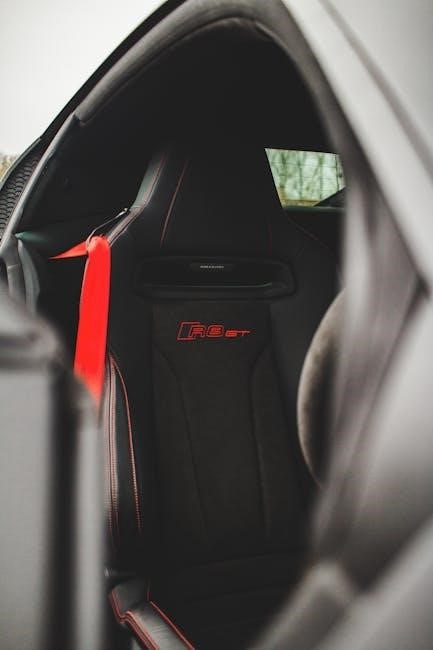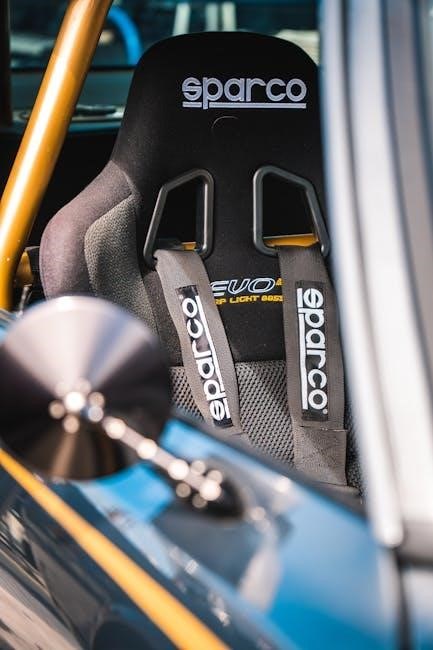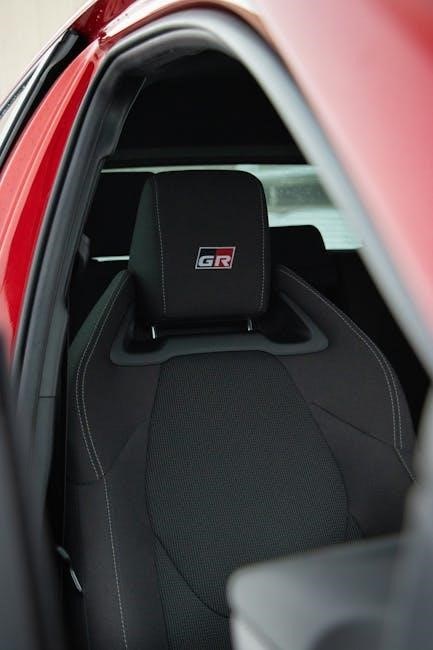Choosing the Right Infant Car Seat
When selecting an infant car seat, consider your child’s size, weight, and height. Choose between rear-facing, convertible, or all-in-one seats. Ensure the seat meets safety standards and fits your vehicle. Set a budget and look for features like easy installation and high safety ratings.

1.1 Types of Infant Car Seats
Infant car seats are designed to protect babies from birth up to a certain weight or height. The most common types include rear-facing seats, which are essential for newborns and young infants, and convertible seats, which can transition from rear-facing to forward-facing as the child grows. All-in-one seats offer even greater versatility, adapting from rear-facing to forward-facing and eventually to a booster seat. Some seats, like i-Size seats, are designed based on a child’s height rather than weight, providing a safer fit for longer. Additionally, rotating seats allow for easier installation and access, while booster seats are used for older children who have outgrown their forward-facing seats but still need extra support. Each type has specific safety features, such as energy-absorbing materials and anti-rebound bars, to enhance protection in the event of a crash. Parents should carefully evaluate their needs and vehicle compatibility when choosing a seat type. Always ensure the seat meets current safety standards and is appropriate for your child’s age, size, and weight.
1.2 Determining the Correct Size and Weight Limit
Determining the correct size and weight limit for your infant car seat is crucial for ensuring your child’s safety. Rear-facing seats typically accommodate infants from birth up to 40-50 pounds (18-23 kg) and 22-35 inches (56-89 cm) in height. Convertible seats offer higher weight limits, often up to 65 pounds (29 kg), and are suitable for longer use. Always check the seat’s labels for specific weight and height restrictions, as these vary by model. i-Size seats are based on your child’s height, typically covering 40-105 cm, and are designed to keep your child rear-facing longer for enhanced safety. Ensure your child’s head is at least 1 inch (2.5 cm) below the top of the seat for proper fit. Parents should also verify that the seat fits well in their vehicle and that the harness is snug, with the chest clip at armpit level. Avoid transitioning your child to the next seat type too early, as this can compromise safety. Always follow the manufacturer’s guidelines and double-check local regulations for size and weight requirements. Accurate sizing ensures optimal protection in the event of a crash.
1.3 Budget Considerations
When choosing an infant car seat, budget considerations are essential but should not compromise safety; Seats can range from under $50 to over $300, offering varying features. Basic models may lack premium features like extra padding or easy-install systems but still meet safety standards. Mid-range seats often provide a balance of safety, comfort, and convenience. High-end models include advanced features like load legs, anti-rebound bars, and breathable fabrics. Consider the seat’s lifespan and whether it can be used for multiple children, which may justify a higher initial investment. Additionally, some seats grow with your child, reducing the need for frequent replacements. Always check for sales, discounts, or second-hand options, but ensure used seats are in excellent condition and not expired. Prioritize features that enhance safety and ease of use, but stay within your means. A well-chosen seat within your budget ensures both financial and safety needs are met. Researching and comparing models can help you find the best value for your money.
1.4 Key Features to Look For
When selecting an infant car seat, prioritize features that enhance safety, comfort, and ease of use. Look for a seat with a load leg or anti-rebound bar, which help absorb crash forces and reduce movement. A LATCH (Lower Anchors and Tethers for Children) system ensures secure installation. Ensure the seat has a sturdy, lightweight frame and side impact protection. Adjustable headrests and harnesses accommodate growing children, while a no-rethread harness simplifies height adjustments. Check the weight and height capacity to ensure it fits your child for as long as possible. Breathable, washable fabrics and a canopy for sun protection are practical additions. Some seats offer a rotating feature for easier loading and unloading. Consider a seat with a built-in level indicator for proper installation. Advanced features like smart technology that alerts you if the seat is improperly installed or if the child is unbuckled can add extra peace of mind. Safety 1st seats often include these innovations. Always verify that the seat meets federal safety standards and has good crash test ratings. These features collectively ensure your child’s safety and your convenience.

Installing and Maintaining the Car Seat
Proper installation is crucial for safety. Follow the manufacturer’s instructions for rear-facing or forward-facing setups. Use the vehicle’s LATCH system or seatbelt, and ensure the seat is snug and level. Regularly check for proper fit and tighten as needed. Avoid common mistakes like incorrect belt routing or loose installation. Schedule periodic inspections and stay updated on recalls or maintenance requirements. Always refer to the user manual or consult a safety expert for guidance. Regular checks ensure your child’s car seat remains safe and secure over time. Proper installation and ongoing maintenance are vital to protect your child in the event of a crash. If unsure, seek help from a certified technician or local safety resources. Consistent care ensures optimal safety and peace of mind for parents. Always verify that the seat meets current safety standards and regulations. This step is essential to safeguard your child’s well-being on the road. Stay informed about updates and best practices to maintain safety. Proper installation and maintenance are non-negotiable for your child’s protection. Never skip these steps, as they are critical to ensuring the seat functions as intended. By following these guidelines, you can create a safer environment for your child during every journey. Regular inspections and adherence to instructions are key to maintaining safety standards. Always prioritize your child’s safety by ensuring the car seat is correctly installed and well-maintained. This responsibility is paramount for protecting your child on the road. Stay vigilant and proactive in maintaining your child’s car seat to ensure their safety at all times. Proper installation and maintenance are the cornerstones of car seat safety. Never compromise on these steps to guarantee your child’s protection. Always double-check the seat’s position and fit to ensure it is secure. This attention to detail is vital for your child’s safety. By following these guidelines, you can create a safer environment for your child during every journey. Stay informed and proactive to maintain the highest safety standards for your child’s car seat. Proper installation and regular checks are essential to ensure your child’s safety on the road. Always adhere to the manufacturer’s instructions and safety guidelines to protect your child effectively. This careful approach ensures your child’s car seat remains safe and reliable over time. Stay committed to these practices to safeguard your child’s well-being during every trip. Proper installation and maintenance are critical for ensuring your child’s car seat functions correctly in case of an accident. Never overlook these steps, as they are essential for your child’s protection. Always prioritize your child’s safety by ensuring their car seat is correctly installed and regularly inspected. This responsibility is crucial for their well-being on the road. Stay informed and proactive to maintain the highest safety standards for your child’s car seat. Proper installation and maintenance are vital for ensuring your child’s safety during every journey. Always follow the manufacturer’s instructions and safety guidelines to protect your child effectively. This careful approach ensures your child’s car seat remains safe and reliable over time. Stay committed to these practices to safeguard your child’s well-being during every trip. Proper installation and maintenance are critical for ensuring your child’s car seat functions correctly in case of an accident. Never overlook these steps, as they are essential for your child’s protection. Always prioritize your child’s safety by ensuring their car seat is correctly installed and regularly inspected. This responsibility is crucial for their well-being on the road. Stay informed and proactive to maintain the highest safety standards for your child’s car seat. Proper installation and maintenance are vital for ensuring your child’s safety during every journey. Always follow the manufacturer’s instructions and safety guidelines to protect your child effectively. This careful approach ensures your child’s car seat remains safe and reliable over time. Stay committed to these practices to safeguard your child’s well-being during every trip. Proper installation and maintenance are critical for ensuring your child’s car seat functions correctly in case of an accident. Never overlook these steps, as they are essential for your child’s protection. Always prioritize your child’s safety by ensuring their car seat is correctly installed and regularly inspected. This responsibility is crucial for their well-being on the road. Stay informed and proactive to maintain the highest safety standards for your child’s car seat. Proper installation and maintenance are vital for ensuring your child’s safety during every journey. Always follow the manufacturer’s instructions and safety guidelines to protect your child effectively. This careful approach ensures your child’s car seat remains safe and reliable over time. Stay committed to these practices to safeguard your child’s well-being during every trip. Proper installation and maintenance are critical for ensuring your child’s car seat functions correctly in case of an accident. Never overlook these steps, as they are essential for your child’s protection. Always prioritize your child’s safety by ensuring their car seat is correctly installed and regularly inspected. This responsibility is crucial for their well-being on the road. Stay informed and proactive to maintain the highest safety standards for your child’s car seat. Proper installation and maintenance are vital for ensuring your child’s safety during every journey. Always follow the manufacturer’s instructions and safety guidelines to protect your child effectively. This careful approach ensures your child’s car seat remains safe and reliable over time. Stay committed to these practices to safeguard your child’s well-being during every trip. Proper installation and maintenance are critical for ensuring your child’s car seat functions correctly in case of an accident. Never overlook these steps, as they are essential for your child’s protection. Always prioritize your child’s safety by ensuring their car seat is correctly installed and regularly inspected. This responsibility is crucial for their well-being on the road. Stay informed and proactive to maintain the highest safety standards for your child’s car seat. Proper installation and maintenance are vital for ensuring your child’s safety during every journey. Always follow the manufacturer’s instructions and safety guidelines to protect your child effectively. This careful approach ensures your child’s car seat remains safe and reliable over time. Stay committed to these practices to safeguard your child’s well-being during every trip. Proper installation and maintenance are critical for ensuring your child’s car seat functions correctly in case of an accident. Never overlook these steps, as they are essential for your child’s protection. Always prioritize your child’s safety by ensuring their car seat is correctly installed and regularly inspected. This responsibility is crucial for their well-being on the road. Stay informed and proactive to maintain the highest safety standards for your child’s car seat. Proper installation and maintenance are vital for ensuring your child’s safety during every journey. Always follow the manufacturer’s instructions and safety guidelines to protect your child effectively. This careful approach ensures your child’s car seat remains safe and reliable over time. Stay committed to these practices to safeguard your child’s well-being during every trip. Proper installation and maintenance are critical for ensuring your child’s car seat functions correctly in case of an accident. Never overlook these steps, as they are essential for your child’s protection. Always prioritize your child’s safety by ensuring their car seat is correctly installed and regularly inspected. This responsibility is crucial for their well-being on the road. Stay informed and proactive to maintain the highest safety standards for your child’s car seat. Proper installation and maintenance are vital for ensuring your child’s safety during every journey. Always follow the manufacturer’s instructions and safety guidelines to protect your child effectively. This careful approach ensures your child’s car seat remains safe and reliable over time. Stay committed to these practices to safeguard your child’s well-being during every trip. Proper installation and maintenance are critical for ensuring your child’s car seat functions correctly in case of an accident. Never overlook these steps, as they are essential for your child’s protection. Always prioritize your child’s safety by ensuring their car seat is correctly installed and regularly inspected. This responsibility is crucial for their well-being on the road. Stay informed and proactive to maintain the highest safety standards for your child’s car seat. Proper installation and maintenance are vital for ensuring your child’s safety during every journey. Always follow the manufacturer’s instructions and safety guidelines to protect your child effectively. This careful approach ensures your child’s car seat remains safe and reliable over time. Stay committed to these practices to safeguard your child’s well-being during every trip. Proper installation and maintenance are critical for ensuring your child’s car seat functions correctly in case of an accident. Never overlook these steps, as they are essential for your child’s protection. Always prioritize your child’s safety by ensuring their car seat is correctly installed and regularly inspected. This responsibility is crucial for their well-being on the road. Stay informed and proactive to maintain the highest safety standards for your child’s car seat. Proper installation and maintenance are vital
Prepare the Vehicle: Ensure the back seat is clear of objects and the seatbelt is accessible. If using the LATCH system, locate the anchors in your vehicle. Position the Car Seat: Place the infant car seat in the rear-facing position, typically in the center of the back seat for maximum safety. Secure the Base: If your car seat has a base, attach it using the LATCH straps or seatbelt. Tighten the straps until the base is firmly in place and level. Attach the Seat to the Base: Connect the infant seat to the base, ensuring it clicks securely and is tightly fastened. Check the Fit: Ensure the seat is snug and level. Use the built-in level indicator or pool noodles to achieve the correct angle for rear-facing installation. Tighten the Straps: Pull the seatbelt or LATCH straps to ensure there is no slack. The seat should not move more than one inch in any direction. Final Check: Double-check all connections and the seat’s position. Refer to the user manual for specific instructions. Test the Installation: Sit in the seat gently to ensure it doesn’t shift. If using a seatbelt, pull it tight and verify the seat’s stability. Regular Inspections: After installation, periodically inspect the seat to ensure it remains secure and properly positioned. Always follow the manufacturer’s instructions and consider consulting a certified technician if unsure. Proper installation is crucial for your child’s safety. Ensuring your infant car seat is compatible with your vehicle is crucial for safety. Always check your vehicle’s manual to understand its car seat anchorage systems, such as LATCH (Lower Anchors and Tethers for Children) or seatbelt installation options. Some vehicles may have specific requirements for car seat placement. The safest position for an infant car seat is in the rear-facing orientation, typically in the center of the back seat. This minimizes the risk of injury from airbags or doors. Avoid placing the car seat in the front seat, especially if your vehicle has an active passenger airbag. For vehicles with smaller back seats, consider using a car seat with a compact base or adjustable features to ensure proper fit. If your vehicle lacks LATCH anchors, use the seatbelt to secure the car seat, following the manufacturer’s instructions. When placing the car seat, ensure it is snug against the vehicle seat and does not move more than one inch in any direction. Avoid leaving gaps between the car seat and the vehicle seat, as this can compromise safety in a crash. For larger families or vehicles with limited space, consider car seats designed for tight fits or multiple car seats. Always refer to your vehicle and car seat manuals for specific guidance on compatibility and placement. Remember, proper placement and compatibility are essential to ensure your child’s safety on the road.2.1 Step-by-Step Installation Guide


2.5 Regular Maintenance and Updates
2.2 Vehicle Compatibility and Placement